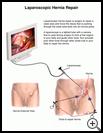
Laparoscopic Hernia Repair
________________________________________________________________________
KEY POINTS
- When you have a hernia, part of the intestine or other tissue bulges through a weak area or gap in the muscles in or near the wall of your belly. Hernia repair is surgery to repair the weak area. A laparoscope is a lighted tube with a camera that is used during surgery. The tissue that is pushing through the weak area is moved back into its normal place.
- Ask your provider how long it will take to recover and how to take care of yourself at home.
- Make sure you know what symptoms or problems you should watch for and what to do if you have them.
________________________________________________________________________
What is laparoscopic hernia repair?
When you have a hernia, part of the intestine or other tissue bulges through a weak area or gap in the muscles in or near the wall of your belly. There are several types of hernia, such as:
- Inguinal (groin)
- Femoral (groin)
- Ventral, also called incisional (from previous surgery in your abdomen)
- Umbilical (belly button)
A hernia repair is surgery to repair the weak area and move the tissue that is pushing through the weak area back into its normal place. Hernia repair is surgery to repair the weak area. A laparoscope is a lighted tube with a camera that is used during surgery to look at the organs in your belly and guide other tools. Your provider puts other tools through other small cuts in your belly. This is called a laparoscopy.
When is it used?
A hernia may need to be repaired with surgery to relieve symptoms or to avoid serious problems. A hernia can become a serious problem if your intestines get trapped in the gap between the muscles. Then blood cannot get to that part of your intestines and part of the intestines may die. This can make you very sick and be life-threatening.
Hernias can be repaired with an open surgery or with a laparoscopy. Discuss both types of surgery with your healthcare provider. The time needed to recover from a laparoscopy is shorter than if you have open surgery. You will also have smaller incisions.
How do I prepare for this procedure?
- Make plans for your care and recovery after you have the procedure. Find someone to give you a ride home after the procedure. Allow for time to rest and try to find other people to help with your day-to-day tasks while you recover.
- Follow your provider's instructions about not smoking before and after the procedure. Smokers may have more breathing problems during the procedure and heal more slowly. It is best to quit 6 to 8 weeks before surgery.
- You may or may not need to take your regular medicines the day of the procedure. Tell your healthcare provider about all medicines and supplements that you take. Some products may increase your risk of side effects. Ask your healthcare provider if you need to avoid taking any medicine or supplements before the procedure.
- Tell your healthcare provider if you have any food, medicine, or other allergies such as latex.
- Your healthcare provider will tell you when to stop eating and drinking before the procedure. This helps to keep you from vomiting during the procedure.
- Follow any other instructions your healthcare provider may give you.
- Ask any questions you have before the procedure. You should understand what your healthcare provider is going to do. You have the right to make decisions about your healthcare and to give permission for any tests or procedures.
What happens during the procedure?
You will be given general anesthesia to keep you from feeling pain during the procedure. General anesthesia relaxes your muscles and puts you into a deep sleep.
Your healthcare provider will make several small cuts in the belly. Air will be passed into your belly, and your healthcare provider will use the laparoscope to see inside. Other instruments will be passed through the other cuts.
During the surgery, your provider will usually put a piece of mesh over the weak spot in your belly wall, creating a newer, stronger wall. Your provider will then close the cuts in your belly.
What happens after the procedure?
You may be able to go home later on the day of the surgery. You may stay at the hospital for 1 or more days, depending on your condition.
Ask your healthcare provider:
- How long it will take to recover
- If there are activities you should avoid, such as lifting, and when you can return to your normal activities, including work
- How to take care of yourself at home
- What symptoms or problems you should watch for and what to do if you have them
Make sure you know when you should come back for a checkup. Keep all appointments for provider visits or tests.
What are the risks of this procedure?
Every procedure or treatment has risks. Some possible risks of this procedure include:
- You may have problems with anesthesia.
- You may have infection or bleeding.
- Other parts of your body may be injured during the surgery.
Ask your healthcare provider how these risks apply to you. Be sure to discuss any other questions or concerns that you may have.

